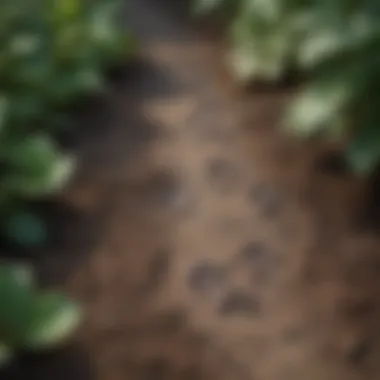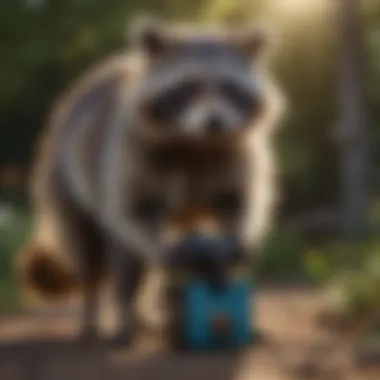Expert Tips for Managing Raccoon Issues in Your Outdoor Space


Preventive Pest Control Strategies House Exterior Protection In order to safeguard your home from raccoon invasions, it is critical to implement effective preventive pest control measures. Begin by focusing on your house exterior's protection. One vital aspect is sealing any cracks or gaps where raccoons could potentially enter. Conduct a thorough inspection of your home's exterior to identify these vulnerable points and use sturdy materials to seal them off effectively. Moreover, ensure that your yard is clear of debris that could serve as hiding spots for pests. Regularly clean up fallen branches, leaves, and any clutter that might attract raccoons towards your property. To further fortify your defenses, consider installing barriers or fencing to prevent pests from gaining access. Yard Maintenance A well-maintained yard plays a significant role in deterring raccoons and other pests from infiltrating your outdoor space. Implement essential yard care routines that focus on keeping your surroundings tidy and organized. Regularly mow the grass, prune overgrown bushes, and trim tree branches that could provide easy access to raccoons. Additionally, use methods like composting to manage organic waste properly, reducing the chances of attracting wildlife. By maintaining a clean and well-kept yard, you create an environment that is less inviting to raccoons and other potential pests. Indoor Cleanliness Indoor cleanliness is key to preventing pest infestations inside your home. Follow expert cleaning tips and techniques to maintain a pest-resistant indoor environment. Regularly vacuum and sweep floors, wiping down surfaces to eliminate food crumbs and spills that may attract raccoons. Pay special attention to areas like kitchens and pantries, where food sources are abundant. By keeping your indoor spaces clean and clutter-free, you make it less appealing for raccoons to explore and settle in. Garbage Disposal Proper garbage disposal is essential in deterring raccoons from rummaging through your waste. Adopt efficient waste disposal methods such as using secure bins with tight-fitting lids to prevent pests from accessing the contents. It's crucial to dispose of garbage regularly and correctly, avoiding leaving bags outside overnight as it can attract raccoons searching for food. By prioritizing proper garbage disposal practices, you minimize the chances of raccoons being drawn to your property in search of easy meals. Other Pest Prevention Strategies Aside from the aforementioned measures, consider incorporating innovative strategies to safeguard your home against raccoons and other pests effectively. Experiment with natural repellents like peppermint oil or vinegar sprays, which can deter raccoons without harming them. Utilize ultrasonic devices that emit sounds unpleasant to raccoons, encouraging them to stay away from your premises. Additionally, explore composting options that reduce food waste odors, making your yard less appealing to wildlife. By combining various prevention methods, you create a comprehensive defense system against potential raccoon problems in your backyard.
Understanding Raccoon Behavior
This section delves deep into the intricacies of raccoon behavior and its significance in effectively addressing raccoon problems in your backyard. Understanding the behavior of these elusive creatures is paramount to implementing successful prevention strategies and ensuring the safety of your outdoor space. By grasping the nocturnal habits, omnivorous diet, and adaptive intelligence of raccoons, homeowners can make informed decisions to mitigate conflicts and safeguard their surroundings.
Nocturnal Habits
Raccoons possess a fascinating behavior of being primarily active during the night. This nocturnal behavior sets them apart from diurnal animals and influences their interactions with humans. The nighttime activity of raccoons plays a pivotal role in their foraging patterns and preference for dark, secluded areas. Understanding their inclination towards nocturnal exploration can aid homeowners in devising strategies to deter raccoons during their peak activity hours. Despite the mischevious tendency of raccoons at night, their adaptability to low light conditions makes them efficient hunters in the darkness, resulting in a unique wildlife spectacle in your backyard.*
Omnivorous Diet
One of the striking characteristics of raccoons is their omnivorous diet, ranging from fruits and vegetables to small animals and insects. This dietary versatility underscores their adaptability to various environments and food sources. By consuming a wide array of foods, raccoons play a vital role in the ecosystem while also posing challenges for homeowners. Their opportunistic feeding habits lead them to raid gardens, trash cans, and bird feeders in search of sustenance. Understanding the diversity of their diet is essential in implementing preventive measures by eliminating attractants and securing food sources, ensuring a harmonious coexistence between raccoons and human habitats.


Adaptive and Intelligent Animals
Raccoons exhibit high levels of adaptability and problem-solving skills, making them formidable adversaries in suburban settings. Their intelligence enables them to overcome obstacles, manipulate objects, and navigate diverse environments with ease. This adaptability, coupled with their dexterous paws and curious nature, allows raccoons to thrive in urban landscapes. By acknowledging their cognitive abilities and resourcefulness, homeowners can appreciate the challenges posed by raccoons and implement effective strategies to deter and manage their presence. Relying on their innate intelligence, raccoons continually test boundaries and seek out new opportunities, necessitating proactive measures to protect properties from unwarranted intrusions.]
Signs of Raccoon Presence
Knocked-Over Trash Bins
Exploring the specific behavior of raccoons tipping over trash bins in search of food sheds light on their resourcefulness and adaptability. Raccoons, in their relentless quest for sustenance, often target easily accessible trash cans, leveraging their intelligence to find food sources in urban environments. This behavior not only reflects their omnivorous diet but also showcases their ability to problem-solve to meet their dietary needs.
Droppings and Tracks
Delving into the significance of identifying raccoon droppings and tracks unveils a valuable method for confirming raccoon presence. By keenly observing and differentiating raccoon droppings from other animal waste, you can gain insights into the frequency of raccoon visits. Similarly, tracking raccoon footprints provides tangible evidence of their nightly excursions, aiding in strategizing effective preventive measures.


Preventive Measures
Secure Trash Bins
Among the essential preventive measures, securing your trash bins is paramount. Raccoons are notorious for rummaging through garbage in search of food, making inadequately secured bins an open invitation. By utilizing tightly sealed bins, you create a barrier that hinders raccoons' access to potential food sources. These bins feature sturdy lids that can withstand raccoons' attempts to open them, preventing mess and odors in your backyard. Additionally, sealed bins reduce the chances of raccoons spreading trash around your property, minimizing the cleanup efforts required. While it may seem simple, the act of securing your trash bins significantly contributes to discouraging raccoons and promoting a clean outdoor environment.
Remove Food Sources
Another critical aspect of preventive measures involves eliminating food sources that attract raccoons. Leaving pet food or fallen fruits in your yard can inadvertently invite raccoons to visit regularly, leading to potential infestations. By promptly removing these food items or securing them in raccoon-proof containers, you eliminate the temptation for raccoons to explore your property. This action not only safeguards your outdoor space but also reduces the risk of raccoons becoming dependent on human-provided food, contributing to their natural foraging behavior. Preventing easy access to food sources is a fundamental step in deterring raccoons and encouraging them to seek nourishment elsewhere.
Install Motion-Activated Lights
Installing motion-activated lights is an effective way to deter raccoons from entering your property. These lights are triggered by movement, illuminatimg the area and startling raccoons, prompting them to retreat. The key characteristic of motion-activated lights is their ability to provide instant illumination upon detecting motion, acting as a reliable deterrent during the night when raccoons are most active. One unique feature of these lights is their energy efficiency, as they only activate when motion is sensed, conserving electricity in the long run. While motion-activated lights serve as a practical solution to discourage raccoons, they also offer added security benefits for your property by alerting you to potential intruders or wildlife presence.


Handling Raccoon Infestations
When facing the challenge of raccoon infestations in your backyard, it becomes imperative to tackle this issue with diligence and expertise. Raccoons, with their nocturnal habits and adaptive nature, can pose a significant threat to your property and well-being. In the grand scheme of dealing with raccoon problems, focusing on the infestation aspect is crucial to ensure a safe and harmonious living environment. By addressing raccoon infestations promptly and effectively, you pave the way for a peaceful coexistence without disruptions or safety concerns.
Contacting Wildlife Removal Services
Professional wildlife removal services stand out as a beacon of hope in the realm of handling raccoon infestations. Their ability to safely relocate raccoons exemplifies their expertise and dedication to resolving wildlife conflicts ethically. By entrusting this task to trained professionals, you ensure the humane treatment of raccoons while safeguarding your property from potential damages. Wildlife removal services not only excel in efficiency but also in minimizing stress and inconvenience for homeowners dealing with raccoon infestations. Their comprehensive approach to relocation aligns seamlessly with sustainable wildlife management practices, fostering a harmonious balance between humans and raccoons.
Professional wildlife removal services can safely relocate raccoons.
The core essence of professional wildlife removal services lies in their capacity to relocate raccoons without causing harm or distress to the animals. This humane approach not only aligns with ethical wildlife management principles but also reflects a sense of responsibility towards cohabiting with nature. The key characteristic that sets professional wildlife removal services apart is their strategic methodology in capturing and transferring raccoons to safer environments. By focusing on the well-being of both humans and wildlife, these services establish a coherent solution that addresses raccoon infestations effectively while respecting the intrinsic value of all living beings. The unique feature of professional wildlife removal services lies in their ability to offer a tailored approach to each infestation scenario, acknowledging the diversity of challenges that each case presents. This adaptability ensures that raccoon relocation is executed with precision and care, minimizing risks and maximizing successful outcomes for both homeowners and raccoons.
Sealing Entry Points
In the realm of preventing raccoon infestations, sealing entry points emerges as a foundational step towards fortifying your property against unwanted intrusions. Raccoons, with their agility and perseverance, can exploit even the smallest openings to access your premises. By proactively closing off any potential entry points, you establish a barrier that deters raccoons from infiltrating your space. This proactive measure not only prevents current infestations but also dissuades future incursions, promoting a long-term solution to raccoon-related challenges.
Close off any openings that raccoons can use to access your property.
The significance of sealing entry points lies in its direct impact on reducing vulnerabilities and strengthening the fortification of your property. By identifying and closing off openings that raccoons can exploit, you eliminate potential entryways and create a secure environment free from wildlife disturbances. The key characteristic of sealing entry points is its proactive nature, which aims to address the root cause of infestations by removing opportunities for raccoons to enter. This strategy not only mitigates risks associated with raccoon presence but also instills a sense of control and ownership over your property. The unique feature of sealing entry points rests in its simplicity and effectiveness, offering a tangible solution that empowers homeowners to take proactive measures in safeguarding their outdoor spaces. While discussing the advantages of sealing entry points, it is essential to highlight its role in promoting peace of mind and instilling a sense of security among residents, thereby fostering a tranquil living environment devoid of raccoon intrusions.



